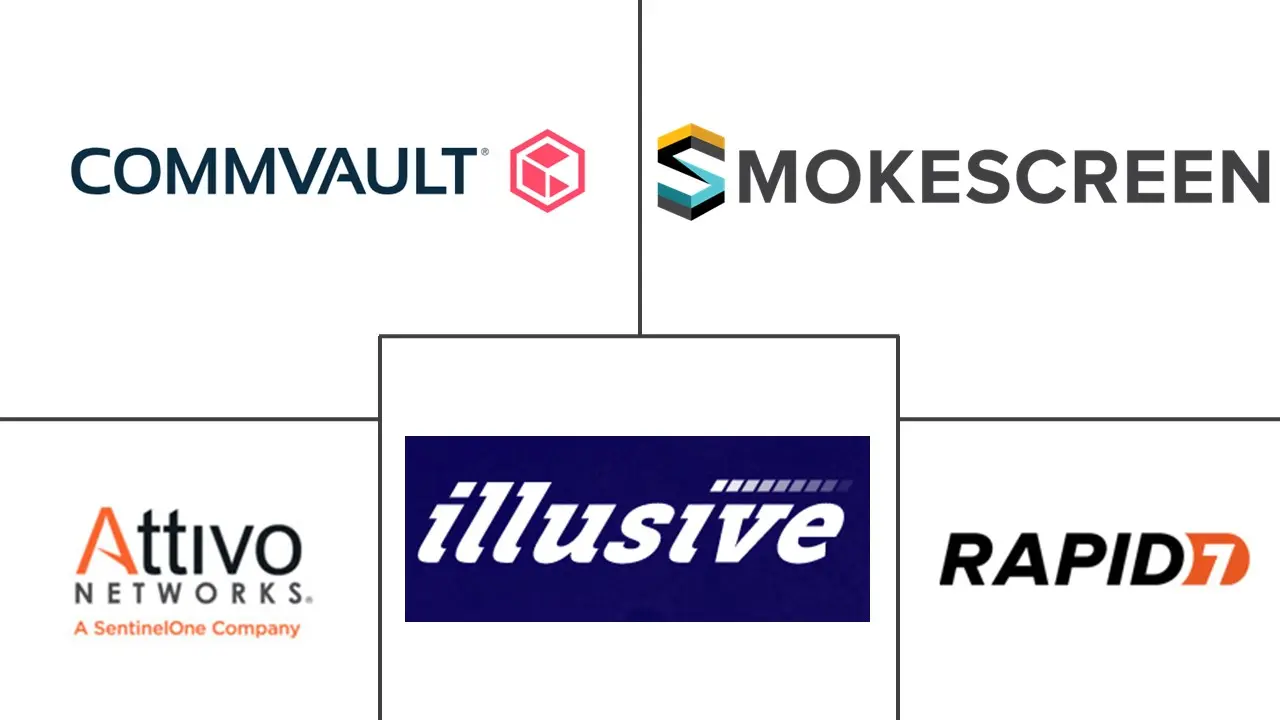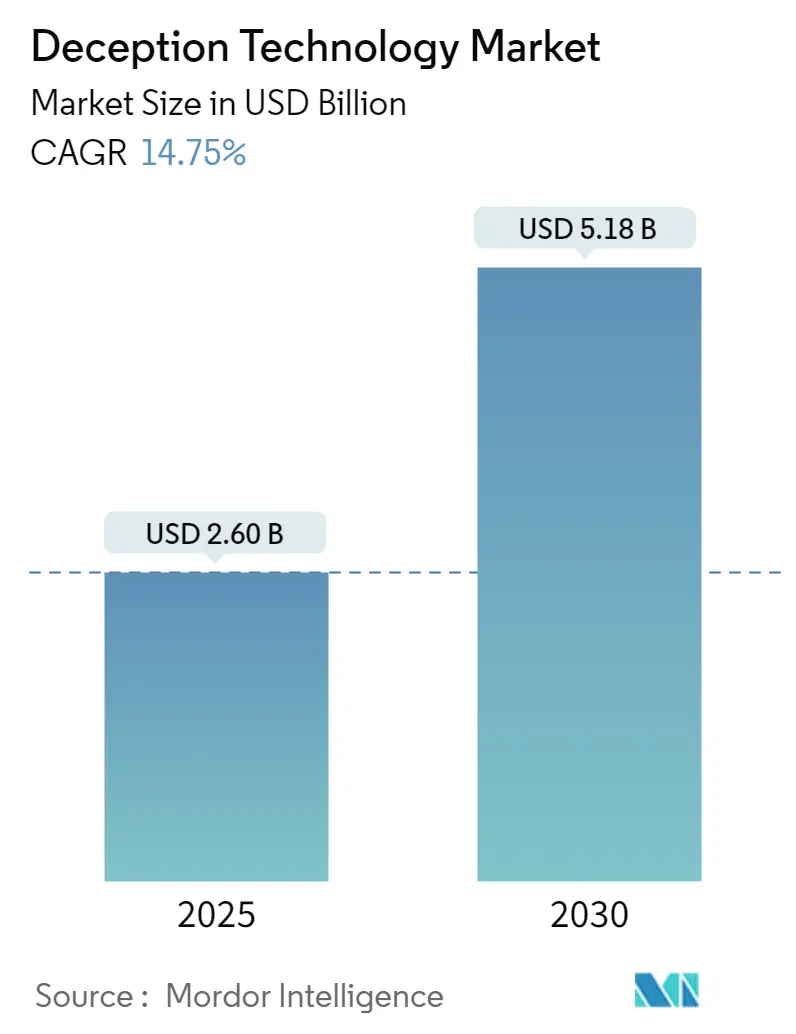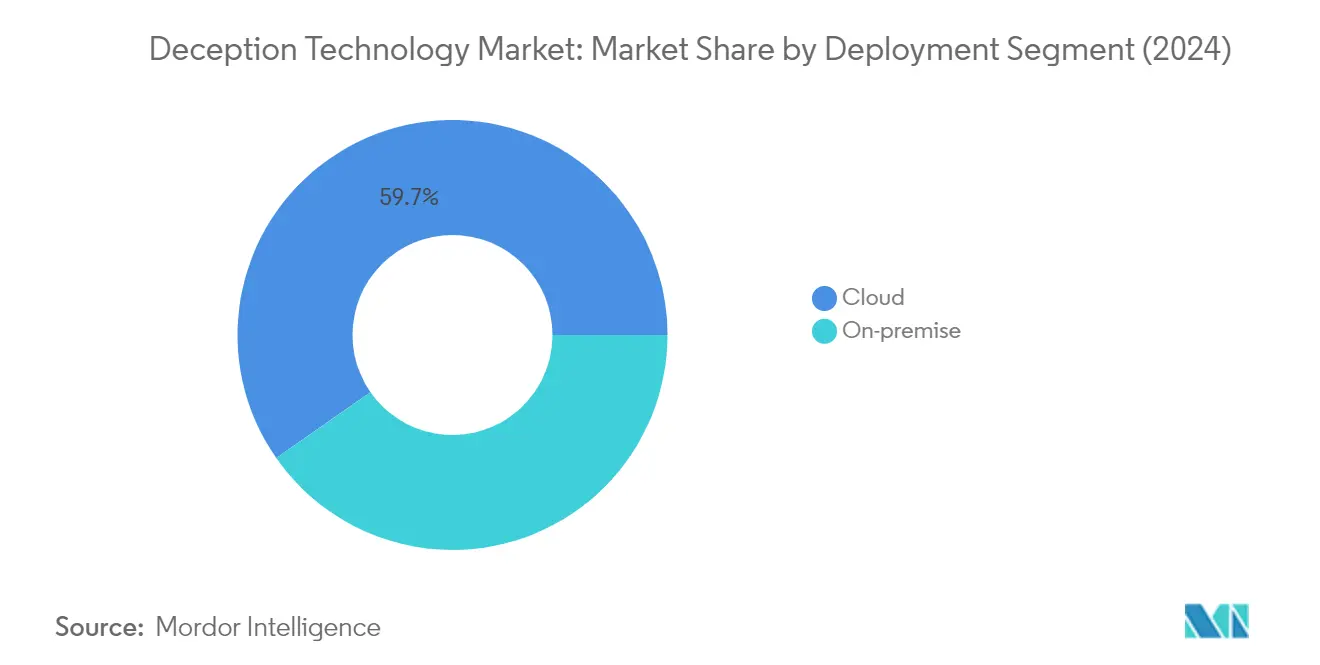Deception Technology Market Analysis
The Deception Technology Market size is estimated at USD 2.60 billion in 2025, and is expected to reach USD 5.18 billion by 2030, at a CAGR of 14.75% during the forecast period (2025-2030).
The deception technology landscape is experiencing significant transformation as organizations grapple with increasingly sophisticated cyber threats and the need for more proactive cyber defense measures. The financial impact of data breaches has reached unprecedented levels, with the global average cost per breach incident rising to USD 4.35 million in 2022, according to IBM's Cost of a Data Breach Report. This escalating cost has prompted organizations to shift from traditional reactive security approaches to more sophisticated deceptive security strategies that can detect and contain threats earlier in the attack lifecycle. The integration of artificial intelligence and machine learning capabilities into deception technology solutions has emerged as a crucial development, enabling dynamic threat detection and reducing operational overhead for security teams.
The proliferation of connected devices and the expansion of attack surfaces have created new challenges for cybersecurity teams, driving the adoption of more advanced deception technology. The Internet of Things (IoT) landscape is projected to expand dramatically, with global IoT connections expected to reach 34.7 billion by 2028, creating an unprecedented number of potential entry points for cyber attackers. Organizations are increasingly deploying cyber deception solutions that can create sophisticated trap environments designed to look and act exactly like existing networks, particularly in cloud environments where traditional security measures may be insufficient. These solutions are becoming more sophisticated, incorporating features such as automated deployment and management capabilities to handle the growing complexity of modern IT infrastructures.
The healthcare sector has emerged as a critical focus area for deception technology deployment, with healthcare organizations facing the highest cost of data breaches at USD 10.10 million per incident. Financial institutions and critical infrastructure providers are also accelerating their adoption of deception technologies, particularly as regulatory requirements become more stringent and cyber attacks more targeted. The integration of deception technology with existing security infrastructure has become more seamless, with vendors focusing on developing solutions that can work in conjunction with Security Information and Event Management (SIEM) systems, Security Orchestration, Automation, and Response (SOAR) platforms, and other security tools.
The market is witnessing a significant shift in adoption patterns, with a growing number of organizations recognizing the value of deception technology in their security strategy. According to the 2022 Cyberthreat Defense Report by CyberEdge and ISC2, 44.1% of surveyed organizations currently use deception technology, while an additional 40.5% plan to implement it within 12 months. This rapid adoption is driven by the technology's ability to provide early cyber threat detection and reduce false positives, allowing security teams to focus on real threats rather than spending resources investigating benign alerts. The industry is also seeing increased innovation in cloud-based deception technology solutions, with vendors developing platforms that can protect assets across hybrid and multi-cloud environments.
Deception Technology Market Trends
Growing Number of Zero-Day and Targeted APTs
The increasing sophistication and frequency of zero-day attacks and Advanced Persistent Threats (APTs) have become a critical concern for organizations worldwide. According to Mandiant Threat Intelligence, 80 zero-day exploits were identified in 2021, more than doubling the previous year's total, with state-sponsored entities, particularly Chinese groups, leading these attacks. The threat landscape has evolved significantly, with nearly one-third of identified actors exploiting zero-days being financially motivated, demonstrating the expanding scope of potential attackers. These vulnerabilities predominantly target widely-used systems from major manufacturers like Microsoft, Apple, and Google, creating a broader risk portfolio for businesses across all industry sectors.
The continued adoption of cloud hosting, mobile technologies, and Internet of Things (IoT) devices has significantly contributed to the rise in zero-day exploits by increasing the volume and complexity of internet-connected systems. In March 2023, Microsoft released updates for approximately 80 newly discovered security vulnerabilities, including two critical zero-day attacks—CVE-2023-23397 and CVE-2023-24880, rated with severity scores of 9.8 and 5.1 respectively on the Common Vulnerability Scoring System (CVSS). Additionally, the emergence of new threat actors like Dark Pink APT, identified in January 2023, targeting government and military entities in the Asia-Pacific region, demonstrates the evolving nature of these threats and their focus on critical infrastructure and sensitive data.
Need for Effective Solutions for Early Detection of Attackers
Early detection capabilities have become crucial in combating sophisticated cyber threats, with organizations seeking solutions that can identify and respond to potential breaches rapidly. According to a National Security Agency (NSA) article, approximately 78% of attackers are detected by deception technology within 20 minutes of breaching the network, highlighting the effectiveness of these solutions in rapid threat identification. This capability is particularly vital as traditional security tools, while effective at identifying anomalies, often struggle to define their impacts and risk potentials, resulting in numerous alerts that require investigation by security teams, many of which turn out to be benign.
The increasing complexity of network architectures and the growing sophistication of attack methodologies have emphasized the need for more proactive detection solutions. Organizations require tools that can provide accurate detection alerting based on security decoy engagement and offer better control and visibility over their networks. This need is further amplified by the rising costs associated with data breaches, as evidenced by IBM's Cost of a Data Breach Report, which revealed that the global average cost per data breach incident increased to $4.35 million in 2022. The implementation of honeypot security enables security teams to focus on real threats by altering the asymmetry of an attack, effectively reducing the time and resources spent on investigating false positives while ensuring critical threats are not overlooked.
Segment Analysis: By Deployment
Cloud Segment in Deception Technology Market
The cloud segment continues to dominate the deception technology market, commanding approximately 60% of the total market share in 2024. This significant market position is driven by the increasing adoption of cloud-based deception solutions that create sophisticated trap environments designed to look and act exactly like existing networks. Cloud deception technology addresses vulnerabilities that attackers might exploit to compromise cloud-based data and workloads by using fake assets hosted in the cloud. The segment's growth is further propelled by the scalability benefits of cloud-based deception technology, which adds in-cloud visibility and awareness to other security measures. Organizations are increasingly preferring cloud deployment due to its ability to provide replicates of technologies and functionalities unique to virtual cloud environments, making it an effective solution for protecting cloud-based assets against potential security breaches.
On-premise Segment in Deception Technology Market
The on-premise deployment segment maintains a significant presence in the deception technology market, offering organizations enhanced control over their data security infrastructure. This deployment model provides businesses with significantly better threat detection compared to cloud deployments, particularly appealing to organizations with strict data sovereignty requirements and those possessing the necessary expertise among staff. The segment's growth is driven by companies that prioritize complete control over their services and data, especially in sectors where data sensitivity is paramount. On-premise solutions are particularly prevalent in regions where cloud technologies are still maturing, and in organizations that require exclusive infrastructure and human resources developed specifically for their firm's needs. The segment continues to evolve with technological innovations, though the high infrastructure investment requirements make it more suitable for large enterprises with substantial resources.
Segment Analysis: By Organization Size
Large Enterprise Segment in Deception Technology Market
Large enterprises continue to dominate the deception technology market, commanding approximately 58% market share in 2024. This significant market presence is driven by their substantial cybersecurity budgets, comprehensive IT infrastructure, and the critical need to protect vast amounts of sensitive data across their complex networks. Large enterprises are increasingly adopting deceptive security solutions to gain early breach detection capabilities and enhanced network visibility across their extensive operations. The hybrid work culture and growing BYOD landscape in these organizations have further accelerated the need for advanced cybersecurity measures, making deception technology an essential component of their security strategy. These organizations are particularly focused on implementing deception technology to protect against sophisticated cyber threats, data breaches, and potential financial losses that could significantly impact their operations and reputation.
SME Segment in Deception Technology Market
The Small and Medium Enterprise (SME) segment is emerging as the fastest-growing segment in the deception technology market, with a projected growth rate of approximately 17% during 2024-2029. This rapid growth is primarily attributed to the increasing recognition among SMEs about their vulnerability to cyber threats and the critical need for enhanced cybersecurity measures. The segment's growth is further fueled by the rising number of targeted attacks on smaller businesses, as cybercriminals often view them as easier targets due to potentially less sophisticated security infrastructure. Cloud-based deception technology solutions are particularly gaining traction among SMEs, as they offer cost-effective ways to implement advanced security measures without requiring extensive in-house IT resources. The segment's growth is also supported by the availability of more affordable and scalable deception technology solutions specifically designed for smaller organizations, making advanced threat detection capabilities more accessible to this market segment.
Segment Analysis: By Service
Professional Services Segment in Deception Technology Market
Professional services dominate the deception technology market, commanding approximately 60% market share in 2024. These services are specifically designed for projects with definitive end dates, where IT staffing firms focus on every project detail from initial brainstorming through final implementation. The segment encompasses various specialized offerings including consulting, training and education, design and system integration, and support and maintenance services. Revenue generation in this segment primarily comes from service contracts that operate on either a time-and-material basis or a fixed fee basis. Professional services are particularly attractive to small-scale companies that may find managed services cost-prohibitive, as they offer more flexibility in terms of project-specific engagements. The segment's strength is further reinforced by the increasing demand for specialized cybersecurity expertise and the growing complexity of cyber threats requiring professional intervention.
Managed Services Segment in Deception Technology Market
The managed services segment is experiencing rapid growth in the deception technology market, with an expected growth rate of approximately 17% during 2024-2029. Unlike professional services, managed services offer comprehensive, long-term solutions that provide organizations with continuous support and expertise. These services are particularly valuable for organizations seeking constant technological updates and support without maintaining an in-house IT team. The growth in this segment is driven by the increasing complexity of cyber threats and the need for 24/7 security coverage. Organizations are increasingly recognizing the benefits of managed services, including more flexible capacity, scalability, and access to specialized expertise. The segment's growth is further supported by the trend of security companies incorporating deception technology into their managed security service provider offerings, providing clients with enhanced threat detection and response capabilities.
Segment Analysis: By Deception Stack
Network Security Segment in Deception Technology Market
Network security emerges as the dominant segment in the deception technology market, commanding approximately 42% market share in 2024. This significant market position is attributed to the increasing complexity of network architectures and the growing need for enhanced security measures across enterprises. With technological advancements like cloud computing, digitization, and automation increasing the threat surface for organizations' networks, network security through deception technology has become crucial for protecting against cyber-attacks and unauthorized access. Organizations across various sectors are implementing network deception solutions to gain better control and visibility over their infrastructure while ensuring accurate detection and alerting based on decoy engagement. The integration of multiple security layers within network security implementations allows organizations to ensure that only authorized users can access networks while effectively blocking malicious actors from executing threats and exploits.
Data Security Segment in Deception Technology Market
The data security segment is positioned as the fastest-growing segment in the deception technology market, expected to grow at approximately 16% through 2024-2029. This accelerated growth is driven by the massive increase in data volumes and data generation across organizations, coupled with the rising need to maintain data confidentiality and prevent unauthorized access. The adoption of various technological advancements, such as cloud computing, digital data, workforce mobility, and automation, has significantly increased the threat to data security, making organizations more vulnerable to both internal and external threats. Security teams are actively working toward enhancing data security measures through deception technology, particularly in sectors like healthcare, financial services, and other data-intensive industries where protecting sensitive information is paramount. The segment's growth is further propelled by stringent data protection regulations and the increasing frequency of sophisticated cyber attacks targeting valuable organizational data.
Remaining Segments in Deception Stack
The application security and endpoint security segments play vital roles in completing the comprehensive deception technology ecosystem. Application security focuses on protecting applications from external threats through software, hardware, and procedural methods, becoming increasingly critical as organizations continue their digital transformation journeys. The segment addresses vulnerabilities in web applications, mobile apps, and network-based applications, providing specialized tools for different application types. Endpoint security, on the other hand, concentrates on securing various endpoints like mobile devices, laptops, and other wireless devices connecting to corporate networks. This segment has gained significance with the rising adoption of BYOD policies and remote work culture, as organizations seek to protect their networks from potential entry points created by these devices. Both segments contribute significantly to creating a multi-layered defense strategy against cyber threats.
Segment Analysis: By End User
BFSI Segment in Deception Technology Market
The Banking, Financial Services and Insurance (BFSI) sector maintains its dominant position in the global deception technology market, commanding approximately 31% of the total market share in 2024. This significant market presence is driven by the sector's continuous advancement in processing and transaction technologies, coupled with the frequent introduction of new and enhanced financial products and services that require robust security solutions. The BFSI industry's critical need for end-to-end security solutions stems from its responsibility to protect sensitive customer information, financial assets, and critical banking infrastructure from increasingly sophisticated cyber threats. The rise of digital banking services through online portals has not only expanded customer reach but also transformed banking into a more interactive and open operational model, utilizing multiple channels for information exchange including internet, mobile, and APIs. This digital transformation has made the sector particularly attractive to cybercriminals, necessitating advanced cyber deception technologies to protect against malware attacks, online phishing, keystroke-logging malware, and identity theft.
IT & Telecommunication Segment in Deception Technology Market
The IT and Telecommunication sector is emerging as the fastest-growing segment in the deception technology market, with a projected growth rate of approximately 16% from 2024 to 2029. This accelerated growth is primarily driven by the increasing complexity of telecom networks and the rising frequency of sophisticated cyber attacks targeting communication infrastructure. Telecom companies are particularly vulnerable to attacks from state-sponsored hackers, sophisticated APT groups, and hacktivists due to their highly complex network environments, including numerous endpoints, user accounts, and diverse infrastructure. The sector's rapid adoption of advanced technologies like 5G, cloud computing, and IoT has created new security challenges, pushing companies to implement more sophisticated digital deception solutions. Many telecom providers are actively partnering with market vendors to enhance their security capabilities, recognizing the critical need to protect both their infrastructure and customer data from evolving cyber threats.
Remaining Segments in End User Market
The deception technology market encompasses several other crucial segments including Government, Medical, Defense, and Other End Users, each with distinct security requirements and implementation approaches. The Government sector focuses on protecting critical infrastructure and sensitive citizen data, while the Medical sector emphasizes securing patient information and healthcare systems from increasing cyber threats. The Defense sector utilizes cyber deception to protect military assets and sensitive information from state-sponsored attacks and sophisticated threat actors. These segments collectively contribute to the market's diversity, with each sector implementing specialized security decoy strategies tailored to their unique security challenges and regulatory requirements. The varying needs across these segments continue to drive innovation in deception technology solutions, leading to more sophisticated and specialized offerings in the market.
Deception Technology Market Geography Segment Analysis
Deception Technology Market in North America
North America continues to dominate the global deception technology market, holding approximately 33% of the market share in 2024. The region's leadership position is primarily driven by the early adoption of advanced security solutions and the robust infrastructure supporting deception technology implementation. The presence of numerous global financial institutions, coupled with the high frequency of sophisticated cyber attacks, has created a strong demand for innovative security solutions. The region's market is characterized by substantial investments in research and development, particularly in areas like artificial intelligence and machine learning integration with deception platforms. The high availability of technical expertise and the presence of major market vendors have further strengthened North America's position. Additionally, stringent regulatory frameworks, such as state-specific privacy laws and cybersecurity requirements, continue to drive the adoption of deception technology across various industries, particularly in highly regulated sectors like financial services, healthcare, and government institutions.
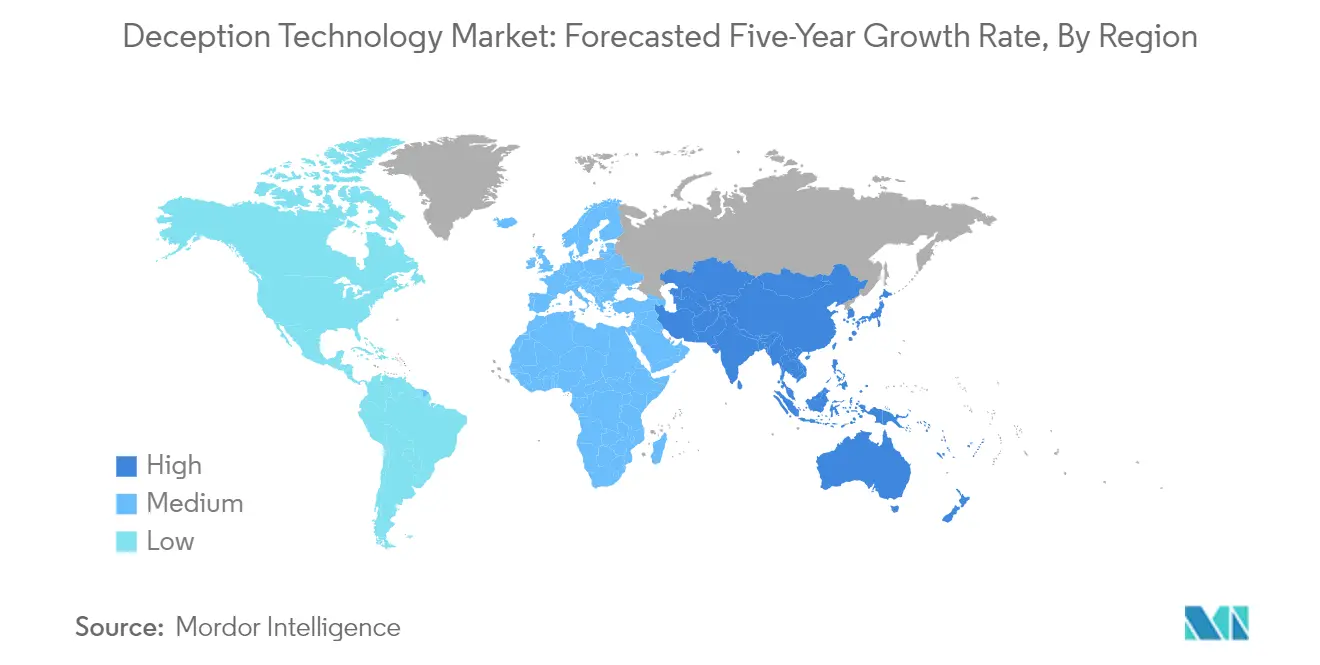
Deception Technology Market in Europe
The European deception technology market has demonstrated robust growth, with an approximate growth rate of 14% during the period 2019-2024. The market's expansion is primarily driven by the region's strong focus on cybersecurity infrastructure and data protection regulations. The European market is characterized by increasing adoption of cloud technology and IoT solutions, particularly in Western and Northern Europe, creating new opportunities for deception technology deployment. The region's commitment to cybersecurity is evident through various government initiatives and strategic frameworks implemented across different countries. The market is seeing particular traction in sectors like banking, healthcare, and government services, where data protection is paramount. European organizations are increasingly recognizing the value of cyber deception as a proactive security measure, especially in the context of evolving cyber threats and sophisticated attack vectors. The presence of strong technical expertise and research capabilities in countries like Germany, France, and the United Kingdom continues to drive innovation in this sector.
Deception Technology Market in Asia-Pacific
The Asia-Pacific deception technology market is positioned for exceptional growth, with a projected CAGR of approximately 18% during the period 2024-2029. This region represents one of the most dynamic and rapidly evolving markets for deception technology solutions. The market is being driven by the rapid digital transformation across various sectors, particularly in emerging economies like India, China, and Southeast Asian nations. The increasing adoption of cloud computing, artificial intelligence, and IoT technologies has created a complex cybersecurity landscape that demands sophisticated protection measures. Organizations across the region are increasingly recognizing the value of deception technology in protecting their digital assets and infrastructure. The market is seeing particular momentum in sectors like banking, telecommunications, and government services, where data security is crucial. The region's growing investment in cybersecurity infrastructure, coupled with increasing awareness about advanced persistent threats, is creating favorable conditions for market expansion.
Deception Technology Market in Latin America
The Latin American deception technology market is experiencing significant transformation as organizations across the region increasingly recognize the importance of advanced cybersecurity measures. The market is characterized by growing adoption of IoT technology and BYOD devices, particularly in major urban centers from Panama City to Rio de Janeiro. Organizations in the region are actively working to strengthen their cybersecurity infrastructure in response to evolving threats and increasing digitalization. The market is seeing particular growth in sectors like banking, government, and telecommunications, where data protection is crucial. Regional governments are increasingly implementing cybersecurity frameworks and regulations, driving the adoption of advanced security solutions. The market is also benefiting from increasing awareness about cyber threats and the need for proactive security measures among organizations of all sizes.
Deception Technology Market in Middle East & Africa
The Middle East and Africa deception technology market is showing promising development, driven by increasing digital transformation initiatives across various sectors. Countries like Saudi Arabia, United Arab Emirates, and South Africa are at the forefront of adopting advanced technologies, including deception-based security solutions. The market is particularly active in sectors such as banking, government services, and telecommunications, where data security is paramount. Regional governments are implementing comprehensive cybersecurity strategies and frameworks, creating favorable conditions for market growth. The increasing focus on digital infrastructure development, particularly in Gulf Cooperation Council countries, is driving the adoption of advanced security solutions. Organizations in the region are increasingly recognizing the value of deception technology in protecting their digital assets and maintaining operational integrity.
Deception Technology Industry Overview
Top Companies in Deception Technology Market
The deception technology market features established players like Illusive Networks, Commvault Systems, Attivo Networks (now part of SentinelOne), Rapid7, and Broadcom (Symantec) leading innovation and market development. Deception technology vendors are heavily investing in research and development to enhance their deception capabilities, particularly focusing on cloud-based solutions and artificial intelligence integration. Strategic partnerships with major technology providers and cybersecurity firms have become increasingly common, enabling comprehensive security solutions and broader market reach. Market leaders are expanding their product portfolios through acquisitions and internal development, with particular emphasis on endpoint security, network protection, and identity management solutions. The industry demonstrates a strong commitment to technological advancement, with companies regularly introducing new features like automated threat detection, real-time response capabilities, and enhanced forensic analysis tools to address evolving cybersecurity challenges.
Dynamic Market with Strong Growth Potential
The deception technology market exhibits a mix of large cybersecurity conglomerates and specialized deception technology companies, creating a diverse competitive landscape. Global players like Broadcom and Akamai Technologies leverage their extensive resources and established customer relationships to maintain market presence, while specialized firms such as Acalvio Technologies and Smokescreen Technologies drive innovation through focused expertise. The market is experiencing significant consolidation through strategic acquisitions, as evidenced by SentinelOne's acquisition of Attivo Networks and Commvault's acquisition of TrapX, indicating a trend toward integrated security solutions.
The competitive dynamics are shaped by increasing partnerships between deception technology vendors and managed security service providers, enabling broader market reach and enhanced service delivery. Market participants are actively expanding their geographical presence, with a particular focus on emerging markets in Asia-Pacific and Europe. The industry demonstrates a healthy balance between established players and innovative startups, with companies like CounterCraft and CyberTrap Software bringing fresh perspectives and specialized solutions to the market, while larger firms continue to strengthen their positions through strategic investments and partnerships.
Innovation and Adaptability Drive Market Success
Success in the deception technology market increasingly depends on providers' ability to deliver comprehensive, scalable solutions that integrate seamlessly with existing security infrastructure. Companies must focus on developing cloud-native solutions, enhancing automation capabilities, and implementing advanced analytics to maintain a competitive advantage. The ability to provide specialized solutions for different industry verticals, particularly in highly regulated sectors like financial services and healthcare, has become crucial for market success. Vendors need to establish strong channel partnerships and develop robust managed service offerings to address the growing demand for simplified security management and expert support.
Market contenders can gain ground by focusing on niche applications, developing innovative cyber deception techniques, and offering flexible deployment options that cater to diverse customer needs. The low threat of substitution products strengthens the market position of established players, while regulatory compliance requirements create opportunities for specialized solutions. End-user concentration in sectors like government, BFSI, and healthcare necessitates deep industry expertise and tailored solutions. Companies must also invest in customer education and support services to address the complexity of cyber deception companies implementation and management, while maintaining strong relationships with technology partners to ensure comprehensive security coverage.
Deception Technology Market Leaders
-
Illusive Networks
-
Commvault Systems Inc.
-
Smokescreen Technologies Pvt. Ltd
-
Attivo Networks Inc. (SentinelOne Inc.)
-
Rapid7 Inc.
- *Disclaimer: Major Players sorted in no particular order
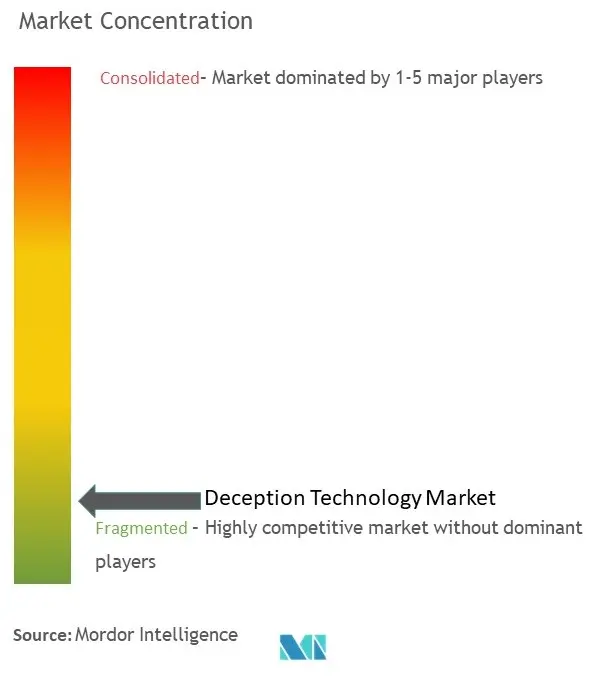
Deception Technology Market News
- March 2023: Rapid7 announced the acquisition of Minerva Labs Ltd., which is a leading provider of anti-evasion and ransomware prevention technology.
- March 2023: Akamai Technologies announced an agreement to acquire Ondat, a cloud-based storage technology provider with a Kubernetes-native platform for running stateful applications anywhere at scale.
- March 2023: Acalvio Technologies announced its partnership with Carahsoft Technology Corp., a government IT solutions provider. Under the agreement, Carahsoft will serve as Acalvio's Master Government Aggregator, making the company's industry-leading Active Defense Platform and ShadowPlex Advanced Threat Defense available to the public sector.
Deception Technology Market Report - Table of Contents
1. INTRODUCTION
- 1.1 Study Assumptions and Market Definition
- 1.2 Scope of the Study
2. RESEARCH METHODOLOGY
3. EXECUTIVE SUMMARY
4. MARKET INSIGHTS
- 4.1 Market Overview
-
4.2 Industry Attractiveness - Porter's Five Forces Analysis
- 4.2.1 Bargaining Power of Suppliers
- 4.2.2 Bargaining Power of Buyers
- 4.2.3 Threat of New Entrants
- 4.2.4 Threat of Substitutes
- 4.2.5 Intensity of Competitive Rivalry
- 4.3 Industry Value Chain Analysis
- 4.4 Impact of COVID-19 on the Market
5. MARKET DYNAMICS
-
5.1 Market Drivers
- 5.1.1 Growing Number of Zero-day and Targeted APT's
- 5.1.2 Need of Effective Solutions for Early Detection of Attackers
-
5.2 Market Restraints
- 5.2.1 High Usage of Legacy Honeypots
6. MARKET SEGMENTATION
-
6.1 By Deployment
- 6.1.1 Cloud
- 6.1.2 On-premise
-
6.2 By Organization Size
- 6.2.1 Small and Medium Enterprises
- 6.2.2 Large Enterprises
-
6.3 By Service
- 6.3.1 Managed Services
- 6.3.2 Professional Services
-
6.4 By Deception Stack
- 6.4.1 Data Security
- 6.4.2 Application Security
- 6.4.3 Endpoint Security
- 6.4.4 Network Security
-
6.5 By End-User
- 6.5.1 Government
- 6.5.2 Medical
- 6.5.3 BFSI
- 6.5.4 Defense
- 6.5.5 IT and Telecommunication
- 6.5.6 Other End-Users
-
6.6 By Geography
- 6.6.1 North America
- 6.6.2 Europe
- 6.6.3 Asia Pacific
- 6.6.4 Latin America
- 6.6.5 Middle East and Africa
7. COMPETITIVE LANDSCAPE
-
7.1 Company Profiles*
- 7.1.1 Illusive Networks
- 7.1.2 Commvault Systems Inc.
- 7.1.3 Smokescreen Technologies Pvt. Ltd
- 7.1.4 Attivo Networks Inc. (Sentinelone Inc.)
- 7.1.5 Rapid7 LLC
- 7.1.6 Ridgeback Network Defense Inc.
- 7.1.7 Akamai Technologies Inc.
- 7.1.8 Acalvio Technologies Inc.
- 7.1.9 CounterCraft SL
- 7.1.10 CyberTrap Software GmbH
- 7.1.11 Fidelis Cybersecurity Inc. (Skyview Capital LLC)
- 7.1.12 LogRhythm Inc.
- 7.1.13 WatchGuard Technologies Inc.
- 7.1.14 NTT Security Limited (Nippon Telegraph and Telephone Corporation)
- 7.1.15 Broadcom Inc. (Symantec Corporation)
8. INVESTMENT ANALYSIS
9. FUTURE OF THE MARKET
Deception Technology Industry Segmentation
The deception technology market is defined based on the revenues generated from the deception stack that is being used by various end-users across the globe. The analysis is based on the market insights captured through secondary research and the primaries. The market also covers the major factors impacting its growth in terms of drivers and restraints.
The scope of the study has been segmented based on deployment (cloud and on-premises), organization size (small and medium enterprises and large enterprises), service (managed services and professional services), deception stack (data security, application security, endpoint security, and network security), and end-user (government, medical, BFSI, defense, IT, telecommunication, and other end users) across the globe. The market sizes and forecasts are provided in terms of value in USD for all the segments.
| By Deployment | Cloud |
| On-premise | |
| By Organization Size | Small and Medium Enterprises |
| Large Enterprises | |
| By Service | Managed Services |
| Professional Services | |
| By Deception Stack | Data Security |
| Application Security | |
| Endpoint Security | |
| Network Security | |
| By End-User | Government |
| Medical | |
| BFSI | |
| Defense | |
| IT and Telecommunication | |
| Other End-Users | |
| By Geography | North America |
| Europe | |
| Asia Pacific | |
| Latin America | |
| Middle East and Africa |
Deception Technology Market Research FAQs
How big is the Deception Technology Market?
The Deception Technology Market size is expected to reach USD 2.60 billion in 2025 and grow at a CAGR of 14.75% to reach USD 5.18 billion by 2030.
What is the current Deception Technology Market size?
In 2025, the Deception Technology Market size is expected to reach USD 2.60 billion.
Who are the key players in Deception Technology Market?
Illusive Networks, Commvault Systems Inc., Smokescreen Technologies Pvt. Ltd, Attivo Networks Inc. (SentinelOne Inc.) and Rapid7 Inc. are the major companies operating in the Deception Technology Market.
Which is the fastest growing region in Deception Technology Market?
Asia Pacific is estimated to grow at the highest CAGR over the forecast period (2025-2030).
Which region has the biggest share in Deception Technology Market?
In 2025, the North America accounts for the largest market share in Deception Technology Market.
What years does this Deception Technology Market cover, and what was the market size in 2024?
In 2024, the Deception Technology Market size was estimated at USD 2.22 billion. The report covers the Deception Technology Market historical market size for years: 2019, 2020, 2021, 2022, 2023 and 2024. The report also forecasts the Deception Technology Market size for years: 2025, 2026, 2027, 2028, 2029 and 2030.
Our Best Selling Reports
Deception Technology Market Research
Mordor Intelligence provides a comprehensive analysis of the deception technology industry. We leverage our extensive expertise in cyber defense and security research. Our latest report examines the evolving landscape of cyber deception and digital deception solutions. It includes advanced threat detection systems and honeypot security implementations. The analysis covers leading deception technology vendors and their innovative approaches to network deception. It explores how cybersecurity deception is revolutionizing intrusion deception strategies. This detailed report PDF is available for download, offering insights into deceptive security measures and security decoy deployment strategies.
The report provides stakeholders with detailed insights into cyber threat detection methodologies. It includes honeynet architectures and cyber trap mechanisms. Our analysis encompasses the complete spectrum of Advanced Threat Protection (ATP) solutions. It offers valuable perspectives on breach detection systems and their implementation. The comprehensive coverage includes detailed profiles of prominent deception technology companies and cyber deception companies. It also includes analysis of emerging threat deception technologies. The report examines the expanding deception technology market size and industry trends, providing actionable intelligence for businesses investing in sophisticated advanced threat protection solutions.

